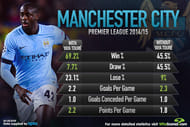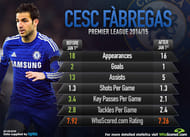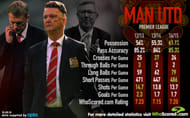Now that the season is coming to a close, it’s remarkable to reflect on some of the debates that opened throughout its course. Things that were supposedly cast-iron truth in November now seem so wrong, or so irrelevant.
It is not just about the crises that always must engulf at least one gulf, or even the hasty calls that Southampton could qualify for the Champions League. It is some of the supposed factors behind these issues. Of course, the nature of these things is that it’s difficult to get the necessary detachment at the time. Now that the season is coming ending, and the picture is virtually complete, it’s easier to start seeing just how true some of those issues were.
Manchester City are better/worse with Yaya Toure
This issue is obviously more complex than a straight-up comparison. The fact that Toure is now 32 means he has probably lost some of his drive, but he still has that game-breaking ability. Some of his strikes this season were among the the best in the campaign, not least the goals at home to Sunderland and away to Crystal Palace. It’s just that, at this point, there isn’t all that much of a difference between City with Toure and without him. The scoring rates - 2.27 with him but 2.15 without him, and a goal conceded per game - aren’t all that different. It does feel that, if City merely need change for the purpose of replenishment, it wouldn’t be the worst thing if a club great were to leave.
Fabregas fades in the second half of the season
For all Jose Mourinho’s argument that Chelsea’s absences from January to May were going to affecCesc Fabregas’ output, it’s still hard to escape the fact his season conformed to the general trend of a career: there was a distinctive drop-off. It’s not even about the assists, which fell from 13 in 18 games to five in 16, but also the key pass: going from 3.39 per game to 2.13.
Manchester United’s philosophy
The oscillating nature of Manchester United’s performances has also led to ever-changing debates about their campaign. It started with the wonder over whether Louis van Gaal had actually improved the side from David Moyes’ time, and what those changes were, before all the fuss over long balls and then finally the obsession with possession and its ultimate purpose. So, how did it end up? The team certainly got attuned to Van Gaal’s idea of possession, with that shooting up from 56% under Alex Ferguson to 61.1%, which was the highest in the Premier League.
They did remain much more comfortable with hitting it long, though, as the 79 long balls were the third highest in the division, only just behind two relegated teams: Burnley and QPR. It does feel as if, for all that Van Gaal has implemented his philosophy, it still needs more of that cutting edge and technical lift - as opposed to a lift in terms of how high they play the ball when desperate - that was seen in the magnificent run that saw wins against Tottenham Hotspur, Liverpool and Manchester City.
Does Arsenal’s latest run actually mean much?
The only problem with all the optimism at the Emirates right now is that, really, we’ve been here before. All the talk about being the best team in a given year is reminiscent of what happened in 2013. There is that perpetual sense of the club self-correcting itself: never suffering the true kind of crisis that would bring them below fourth, but never enjoying the genuine evolution that would lift them to a proper challenge. For the latter to happen, there needs to deeper development of performance. The excellent recent run needs to be an indication of structural improvement, rather than just a streak.
That does seem the case, especially in the defensive side of the game. You only have to look at the drastic increase in tackles and - especially - interceptions, with the latter jumping from 14.3 to 20.3. That kind of aggression offered the platform for sleeker football. Things are looking encouraging - more so than usual.





